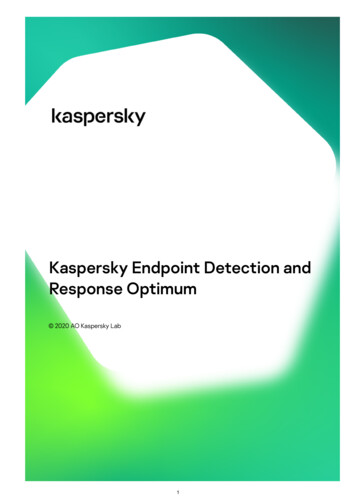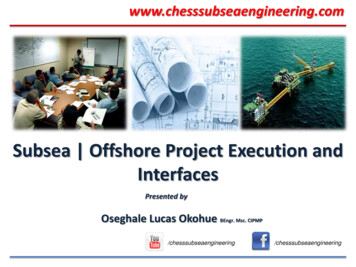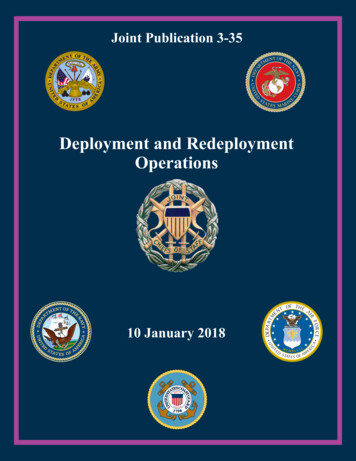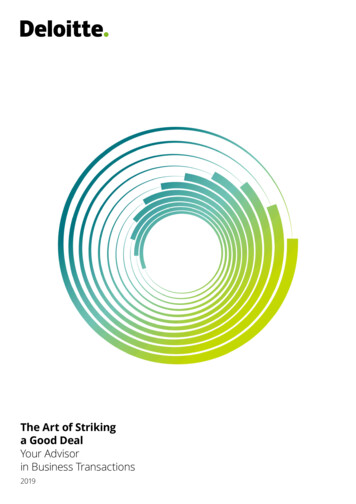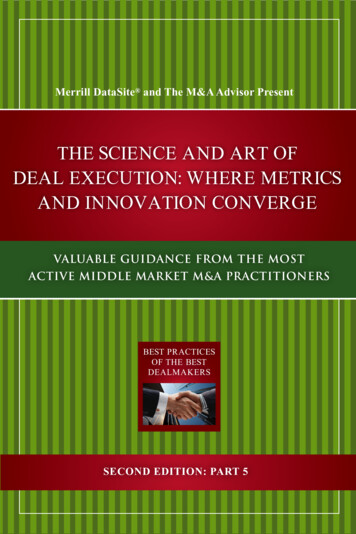
Transcription
Best Practices of the Best DealmakersMerrill DataSite and The M&A Advisor PresentTHE SCIENCE AND ART OFDEAL EXECUTION: WHERE METRICSAND INNOVATION CONVERGEVALUABLE GUIDANCE FROM THE MOSTACTIVE MIDDLE MARKET M&A PRACTITIONERSBEST PRACTICESOF THE BESTDEALMAKERSSECOND EDITION: PART 51
Best Practices of the Best DealmakersWhen it is operating smoothly, the deal executionprocess is as holistic in design and function as one ofLeonardo da Vinci’s hybrid works of science and art.2
Best Practices of the Best DealmakersINTRODUCTIONrawing on the experience and expertise of the “best in class”dealmakers, The M&A Advisor (http://www.maadvisor.com),together with the leading provider of virtual deal managementservices, Merrill DataSite (http://www.datasite.com), publishes thequintessential dealmakers guide series — “The Best Practices of The BestDealmakers.” Profiling the proven strategies and unique experiences of theleading M&A practitioners, “The Best Practices of The Best Dealmakers”series is distributed in regular installments for M&A industry professionalsin both print and interactive electronic media. Previously published featuresand chapters are also available in the online library of Merrill DataSite andThe M&A Advisor. We are pleased to present The Science and Art of DealExecution: Where Metrics and Innovation Converge. This installmentdiscusses the quantitative foundations of dealmaking, the metrics andmeasures that underpin each phase of the deal process. These fundamentalelements allow corporate finance professionals to create their version oftransactional art in an M&A setting. On the following pages you’ll find helpfulobservations from leading buyers, sellers, and advisors, as well as timelyinsights into the most current trends.D3
Best Practices of the Best DealmakersMerrill DataSite is a secure virtual data room (VDR) solution that optimizesthe due diligence process by providing a highly efficient method for sharingkey business information between multiple parties. Merrill DataSite reducestransaction time and expense with: Unlimited access for users worldwide Real-time activity reports Site-wide search at the document level Superior project management service The highest level security certification, ISO 27001:2005Merrill DataSite’s multilingual support staff is available from anywhere in theworld, 24/7, and can have your VDR up and running with thousands of pagesloaded within 24 hours.Click Here to schedule a demo today.4
Best Practices of the Best Dealmakers“I think deal negotiations are 50% science and 50% magic —or art.” Lorie BeersPart 5: The Science and Art of Deal Execution:Where Metrics and Innovation ConvergeIntroductioncientist, painter and quintessential Renaissance man, Leonardo daVinci successfully merged science and art. Today’s corporate financeprofessionals ought to feel some kinship with the great Leonardo.What they do to guide M&A deals from inception to integration has elementsof the two spheres in which Leonardo was an archetypal master. “I think dealnegotiations are 50% science and 50% magic—or art,” declares deal veteranLorie Beers, Senior Managing Director and leader of the investment bankingpractice at Variant Capital Advisors. The science of deal execution, shenotes, “is about running a disciplined, organized, robust process that beginseven before the negotiation phase commences.” Although speaking of dealnegotiation, Ms. Beers’ observation can also be applied to the other criticalcomponents of the deal execution process: valuation, structure and post-closetarget integration. When it is operating smoothly, the process they compose isas holistic in design and function as one of Leonardo’s hybrid works of scienceand art.SIn both Leonardo’s era and our own, scientific and artistic achievementsrequire information as a foundation for the formal process of creationthat follows. That information reservoir helps today’s corporate financeprofessionals—buy-side and sell-side investment bankers, attorneys,accountants, valuation professionals and others—to assemble the quantitativeingredients that form a deal’s DNA and help deal participants achieve thehighest possible level of preparation. Deep preparation, they agree, worksto the best advantage of buyers and sellers. The science aspects of dealexecution, Beers points out, “are more about the process than about the artof negotiation.” If the transaction process is optimized, deal negotiationbecomes easier, even when the process runs into the weeds, as it sometimes5
Best Practices of the Best Dealmakersdoes. Solid preparation enables deal participants to anticipate many of theunknowns. Constant communication with the bidders ensures that there willbe few surprises in the negotiation phase, thus keeping the process dynamic.Preparation also facilitates transparency and disclosure, both of which arecritical to the success of any deal.This chapter of The Best Practices of the Best Dealmakers spotlights thequantitative foundations of dealmaking, the metrics and measures thatunderpin each phase of the deal process and that allow corporate financeprofessionals to create their version of transactional art in an M&A setting.Part I: The Science of Deal NegotiationA. The Goal: Getting the Deal Done“The second bite of the apple—the upside—can actually be greater than anearlier cash-out.” - Dennis Graham, Private Equity Group Practice Leader,Plante MoranIn an M&A transaction, sellers want to sell their companies for the highestpossible price; buyers want to pay the lowest possible price. Despite theapparent disparity of their objectives, sellers and buyers share a goal thatgreases the gears of all M&A negotiations: they want to get a deal done thatbenefits them and their shareholders.Although the valuation of the target company understandably captures theattention of sellers and buyers, there are other points of negotiation, even ata transaction’s outset, that need to be addressed. The terms of the deal mustbe set. If it is not a straight stock purchase, which assets will be transferredto the buyer? Which liabilities will the seller retain? Stock purchases arerelatively simple transactions that generally benefit the seller more than thebuyer. Asset sales, on the other hand, can result in knotty negotiations butare typically of more benefit to the buyer. By negotiating terms beyond thevaluation price, buyers and sellers can discover each other’s top priorities,which will likely result in smoother negotiations by enabling the two sides tomake concessions to build and sustain the deal’s forward momentum. Veterannegotiators recommend making strategic concessions. They also recommendthat the party making the concessions should inform the counterparty ofthe concessions’ strategic importance, and then request an equal concessionfrom the counterparty. Each deal structure carries its own tax consequences,which are also the subject of negotiation. For example, in an asset sale, the6
Best Practices of the Best DealmakersEach deal structure carries its own tax consequences, which arealso the subject of negotiation.buyer can write up the tax bases of the target’s assets, thereby reporting greaterdeductions for depreciation and amortization. Due to various tax penalties,however, seller shareholders may focus on the downside aspects of an assetsale. Conversely, target shareholders may prefer a stock sale because their gainon the transaction is taxed only once, at the shareholder level.According to attorney Randy Bullard, Corporate Department Chair at law firmGreenberg Traurig, in a sell-side mandate the most important issues, beyondprice certainty, are minimized holdbacks—funds that are withheld by thebuyer from the seller until certain conditions, specified in the letter of intent(LOI), are met—minimal contingencies and the avoidance of earn-outs.Earn-outs are arrangements in which sellers receive future payments usuallypegged to their former company’s future earnings.From his vantage point as head of KPMG Corporate Finance LLC in Chicago,Phil Isom outlines several sell-side objectives and concerns:1.) Achieving maximum value, consideration mix and terms—is the buyerwilling to pay and are the negotiating terms reasonable?2.) Speed of execution—is the deal a priority for management?3.) Certainty of completion—does the buyer have the financial resources tocomplete the deal?4.) Partnering with a larger buyer – a large buyer could provide more resourcesto the target, enabling the company to achieve long-term objectives.5.) If the seller is taking stock in the post-close entity, the seller would beinterested in maintaining value in the combined entity.Private equity firms looking to divest a portfolio company often aim theprocess specifically at corporate strategic buyers. These buyer will typically paya premium price, because they assign value to synergies and the acquisition ofnew clients and new business. Financial buyers, on the other hand, typicallyassign the highest priority to return on investment (ROI) calculations.Investment banking organizations often have family-owned middle-marketand lower middle-market companies as sell-side clients. The owners of these7
Best Practices of the Best Dealmakersbusinesses have strong ties to existing management (often generationalmanagement). These owners often prefer a financial buyer to a strategic buyer,because they place a higher value on an investor that is committed to existingmanagement.In his position as Private Equity Group Practice Leader at Plante Moran, aMichigan-based consultancy that provides buy-side financial and tax duediligence, Dennis Graham has often seen tension among sellers over theamount of cash they receive at the close and what they give up later in termsof upside. For private equity firms, the tension emanates from their desire forcontrol and for upside capture, but private equity firms often want the sellers’management teams to have a stake in the achievement of that upside. Recently,however, Graham has noticed an easing of the natural tension between cashnow and upside later. Graham says, “As the private equity and M&A modelhas evolved, many of our private equity funds are able to provide sellers withexamples of instances where the second bite of the apple—the upside—canactually be greater than an earlier cash-out.”Buyers are concerned with whether or not it is important to attract strategicinvestors, new funding sources or non-core investments. Randy Bullard addsthat most of his law firm’s seller clients prefer all-cash transactions, a limiton the contingencies that claw back on the purchase price and a limit oncontingencies that extend payment of the purchase price to a later date postclosing via releases of escrow and multiple closings. The seller’s ideal outcome:a clean one-time closing with the seller exiting the deal process with fullpurchase price in hand.B. The Lawyer’s Role: The Calm Approach“It should never be about the lawyer.” - Randy Bullard, Corporate DepartmentChair, Greenberg TraurigFrom an attorney negotiator’s perspective, there is no one-size-fits-allquantitative approach to deal negotiation. After all, every deal and everyclient is different. The art of negotiation often springs from a calm demeanor,a non-academic listening approach that is never off-putting to a negotiationcounterpart. Says Randy Bullard: “From experience, I’ve found that areasonable, balanced approach is most helpful; I dig my heels into the sandonly when it’s necessary.” Taking the resistant tack less often gives a negotiatormore credibility when resistance is called for. Otherwise, a negotiator’s stancedepends more on the dynamics between buyer and seller, and how much a8
Best Practices of the Best DealmakersExperienced negotiators increase bargaining power byfamiliarizing themselves with the interests and motivations oftheir opposite numbers.buyer wants to buy and a seller wants to sell, not whether a lawyer wins or losesa point. “It should never be about the lawyer,” Bullard cautions.Like most other M&A transaction participants, Bullard’s role in a deal isprescribed. Often the lead partner in M&A transactions, he helps assemblethe structure of the deal and in formulating the strategy for approaching thetarget. As the transaction moves forward toward the LOI he is involved in allaspects of the negotiation, including preparation of contracts, deal strategy,and leading counterparty negotiations. Eventually, as the transaction comestogether, his drafting responsibilities wane. When it comes time to processdeal documentation, he usually assigns the task to a more junior partner fromhis firm or to a senior associate’s assistant. “I don’t just attend the organizationmeeting and disappear,” he declares. “I’m involved in all stages of the dealexecution process.”Veteran dealmakers think beyond price; focusing on other items such as dealstructure often leads to winning bids if dealt with early in the process wherebuyers may be more willing to negotiate to ensure they advance to the secondround. Yet awareness of the valuation range and performance drivers is asimportant as negotiating skill. Experienced negotiators increase bargainingpower by familiarizing themselves with the interests and motivations of theiropposite numbers in order to better understand the counterparty’s organizationand its decision-making drivers.C. The Banker’s Role: Gatekeeper of the Process“If there is only one potential buyer there is a likelihood that the leverage will shiftin favor of the buyer.” - Lorie Beers, Senior Managing Director, Variant CapitalAdvisorsLorie Beers shares Bullard’s affinity for a calm negotiating approach withcounterparties and clients. As an investment banker, her involvement in thedeal process is all-encompassing from start to finish. For sellers, she acts asfinancial advisor, helping the company to develop its go-to-market strategy, theoverall sell-side objective, pricing and gaming out the potential outcomes of thedeal execution process. Depending on the company’s objective, she formulates9
Best Practices of the Best Dealmakersthe deal structure prior to going to market.Once the client is actively in the market, an investment banker serves asspokesperson and lightning rod for the company in conjunction with the dealprocess and the negotiation while advising the target with respect to potentialbuyers. By that point, the bankers are either developing or refining elementsof the potential deal structure, including earn-outs and potential futureconsiderations. Beyond negotiations, Beers’ firm assists the seller in evaluatingand scoring potential bidders, narrowing down the choices in preparationfor management meetings. At the final bid stage, an investment banker aidsthe company in evaluating the quantitative and qualitative aspects of any bid.Explains Beers, “We are the gatekeepers of the process in terms of interfacingwith potential buyers to ensure the process is robust.”The deal process a seller’s investment banker runs is critical to the transaction’ssuccess. In many deals the seller’s banker will post a model stock purchaseagreement (SPA) and an asset purchase agreement (APA) in the virtual dataroom. Developed by the seller, these model agreements are the bulls-eye thatpotential bidders will aim at. Both documents are wish lists of all the terms theseller wants included in the transaction. Whether the wish list is meaningfuldepends on whether the bidding process is competitive. Explains Lorie Beers,“If there is only one potential buyer there is a likelihood that the leverage willshift in favor of the buyer.” If there are several competitive buyers, however, theseller is more likely to obtain all the deal terms sought.When the client is a buyer, the investment banker’s role is largely dependenton conducting a full-on buy-side campaign for the client, if a specific target isbeing pursued or if the advance on the target is unsolicited. In an unsolicitedadvance, bankers make the initial approach to the target. If the target is not inthe market, bankers approach the target to share a vision of what the combinedcompanies would look like. Bankers then work to best position their client tobe the acquirer should the transaction take shape.D. Negotiating Synergy: Let the Buyer Beware“’We are going to cut up X by 10% and grow revenue by an incremental 2%.’Such high-level calculations are prone to risk. I would urge buyers to dig deeperthan that.” Marc Suidan, Deals Partner, PwCLet the buyer beware. So warns Marc Suidan, Deals Partner at PwC in SanFrancisco. A purchase price, he points out, is predicated on realizing synergies10
Best Practices of the Best DealmakersLet the buyer beware.that justify it. Once a company is sold, both the responsibility and the risk forrealizing those synergies.Suidan says that he has seen several synergy quantifications. Most, he insists,consist of the buyer stating, “We are going to cut up X by 10% and growrevenue by an incremental 2%.” Such high-level calculations, he claims, areprone to risk. “I would urge buyers to dig deeper than that.”He advises buyers to break down those synergies into bite-sized bits, discretesmaller value drivers or initiatives that can be owned by a specific leaderin the acquiring company. For instance, an executive could be assignedthe responsibility for reducing general and administrative (G&A) costsby a specified amount, achievable by absorbing the target into the buyer’sexisting environment. “Suddenly, someone is accountable for achievingthose reductions,” says Suidan. Adopting these measures, he says, willincrease the probability of success due to heightened transparency andaccountability. The designated executive was selected, in this case, because ofa deep understanding of the general and administrative field. After enlistingthe appropriate assistance from a company like PwC, the executive wouldbe advised as to how much of the target should be absorbed, how existinginfrastructure could be leveraged, like a fixed cost, to serve the absorbedtarget, and how the variable costs would have to be accommodated. The result,Suidan says, is a quantifiable approach that is more specific, more reliable andmore actionable post-close.E. Preparing the NegotiatorsThe purpose of this information is to provide clients a sense of how high or lowthey can go in terms of possible negotiation concessions and where they need tohold the line.Negotiators need ammunition in the form of incisive and reliable informationin order to fulfill their responsibilities. Duncan Smithson, U.S. West/CentralLeader of Mercer’s Global Private Equity M&A Group, supplies humanresources-related information and strategic advice to client deal negotiators.Smithson advises corporate and private equity buyers and sellers when theyprepare to carry out a transaction. He also mobilizes his firm’s resources11
Best Practices of the Best Dealmakersdepending on the specifics of the deal. He assists clients in building theirvaluation model and in planning for future target integration.“We’re seldom at the table when deal principals are staring into the whites ofeach other’s eyes as they negotiate the granular details of the deal,” Smithsonnotes. Instead, his role is to arm those principals with the appropriateinformation so that they enter negotiations knowing what their most desirableoutcome is, what their fallback position might be and therefore how they couldachieve a compromise with their counterparty.From a HR perspective, the state of U.S. healthcare reform is a consistenthot-button issue. Many of the detailed regulations and much of the legislationrelating to the Affordable Care Act (Obamacare) are in flux. This createsuncertainty and volatility in terms of determining, for instance, the impact ofthe fringe benefit rate—the cost of an employee’s benefits divided by the wagespaid to an employee for the hours working on the job—on the employee basegiven ongoing healthcare reform. It is important, Smithson says, to be ableto inform a client about what the point estimate—the approximate value of aspecified parameter, such as the mean, of a population from random samplesof the population – should be for client costs. It is also important to be able toexplain to a client “that there is a range of volatility around that estimated valueand that the client needs to understand where the costs lie.” This information,provided to clients in the midst of high-level deal negotiations feeds into clients’ability to understand how much volatility—or how much give and take—theyhave at their disposal. Combined with other HR touch points, and other touchpoints across other work streams, the purpose of this information is to provideclients a sense of how high or low they can go in terms of possible negotiationconcessions and where they need to hold the line.F. EBITDA: Where Science and Art Converge“I often tell clients, ‘Here’s your accounting policy, here’s how you’ve beenaccounting for EBITDA historically, but here is the actual GAAP policy.’ ”- Dennis Graham, Private Equity Group Practice Leader, Plante MoranThe science and art aspects of deal negotiation sometimes converge on theissue of EBITDA adjustment during quality-of-earnings analyses, says DennisGraham.EBITDA (earnings before interest, taxes, depreciation and amortization) isan approximate measure of a company’s operating cash flow based on data12
Best Practices of the Best DealmakersThe science and art aspects of deal negotiation sometimesconverge on the issue of EBITDA adjustment.gleaned from the company’s income statement. Since the distorting accountingand financing effects of company earnings do not factor into EBITDA, itis regarded as a sound method of comparing companies within and acrossindustries. Adjustments to EBITDA can include excess owner compensation,non-recurring business expenses and expenses personal to current ownership.Adjusted EBITDA is important to a company’s owners, bankers and potentialbuyers because it represents the normalized free cash flow available to acompany to service proposed debt.Companies in some industries account for EBITDA based on historicalprecedent instead of adhering to the letter of Generally Accepted AccountingPrinciples (GAAP), a discrepancy that often creates a variation. “As weconduct our quality-of-earnings analysis we formulate adjustments tohistorically presented unadjusted EBITDA,” Graham explains. Thoseadjustments, which positively and negatively impact EBITDA, change theperception of adjusted GAAP based EBITDA. Such adjustments, comingafter the signing of the LOI, can alter expectations on the part the buyer andseller. “That’s the science aspect,” Graham says. The “art part,” he adds, occurswhen a deal is struck on a certain basis or price point and deal participantsbecome fixated on that number. Moving a buyer and seller off that numberis often a difficult process for deal negotiators. To untangle the dealmakers,Graham says, tell them, “Here’s your accounting policy, here’s how you’vebeen accounting for EBITDA historically, but here is the actual GAAP policy.”This revelation, he adds, changes the presentation of EBITDA, aligning it withGAAP principles and aids deal participants in understanding the impact onvalue of GAAP-adjusted EBITDA.Part II: V Is for Valuation, the Prime ObjectiveA. Setting Value: What Do Negotiators Aim for?“Finding common ground among the two parties’ perception of the target’svalue drivers makes for a much smoother transaction” - Cindy Ma, ManagingDirector, Houlihan LokeyValuation is the first—and prime—phase of deal execution. Valuation is thebasis for all that follows and the basis for the deal’s bottom line and, ultimately13
Best Practices of the Best DealmakersBuyers and sellers usually enter negotiations aware of the pricethat will kill the deal for them.the ROI. Buyers and sellers usually enter negotiations aware of the price thatwill kill the deal for them. Under a normal circumstance, such as a non-firesale scenario or a sale under regulatory pressure in a limited time frame, aseller has a minimum price in mind while a buyer has a maximum price it willpay for the deal to make financial sense. A transaction happens only whena seller’s minimum price is equal to, or lower than, the maximum price thebuyer is willing to pay.According to Cindy Ma, Managing Director of Houlihan Lokey, a New Yorkbased investment bank, “The seller naturally is perceived as having moreinformation about the asset, and this information asymmetry may create a gapbetween the seller’s and buyer’s target prices. A great deal of effort is requiredto bridge the difference, including the use of outside consultants to evaluateaspects of the target business.”A common hitch in valuation negotiations is one of perception: seller andbuyer may value the target differently. Both parties may differ in their opinionswith respect to industry outlook, competitive landscape and potential risksand opportunities. The unique circumstances surrounding the seller andthe buyer can create contrasting dynamics, such as whether a new targetmanagement team may have a more positive impact on the performance ofthe business, what resources the target has at its disposal and the potentialsynergies the buyer can likely achieve, given the quality of its managementteam, its existing assets, capital position and investor base. These differingperspectives may result in a contrasting outlook that is reflected in thefinancial projections of the target business and ultimately in the anticipatedROI of the company. Declares Ma, “Finding common ground among the twoparties’ perceptions of the target’s value drivers makes for a much smoothertransaction”.B. Market Demand—and Sometimes Multiples of EBITDA—also DriveNegotiations“It’s difficult for the human brain to understand the algebra of the net presentvalue model.” Dennis Graham, Private Equity Group Practice Leader, PlanteMoran14
Best Practices of the Best DealmakersDEAL NOTESThe Contrasting Roles of Valuation Firms: Targeting theValuation Services You NeedTo paraphrase Mick Jagger: When it comes to valuation services, M&A dealmakers can getwhat they need.Depending on needs associated with their size, reach, sophistication and, deal complexity,valuation clients are generally served by two types of valuation firms: full service andtraditional. Full-service valuation firms offer an array of M&A-related corporate finance,financial advisory and financial restructuring services on a global basis when required.Traditional valuation firms provide core valuation services such as financial opinions andaccounting, tax needs, as well as valuations of portfolio and intangible assets. Full-serviceand traditional valuation firms serve the same deal-size clientele: Transactions range fromapproximately 10 million to 10 billion. In addition to the purposes of their respectiveclient service arsenals, the two types of valuation firms also differ in the nature and timeframe involvement in an M&A transaction: full-service firms are generally involved fromthe outset of a deal past the LOI; traditional firms are summoned mainly after a price pointhas been reached and an LOI is near the signing stage.According to Cindy Ma of Houlihan Lokey, her firm can provide a range of servicesaround M&A transactions including M&A advisory, due diligence, valuation, transactionopinions and even dispute resolution. Unlike a pure valuation firm, Houlihan Lokeyprovides advisory services across the entire transaction, with valuation being only one ofthe services it offers.In contrast, traditional valuation firms primarily provide only those services that aredirectly related to valuation. “We often function like a Good Housekeeping Seal ofApproval,” comments Tom Kenny, Senior Vice President of traditional valuation firmMurray Devine. Although sometimes utilized as an additional third party in pretransaction due diligence, Murray Devine mainly provides valuation services, such assolvency opinions when considerable leverage is involved, and fairness opinions, after apurchase price has been set by the buyer and seller. Post-close traditional valuation firmservices usually include purchase price allocation and stock compensation valuations.Overall, he says, “Our valuation is used primarily for accounting purposes to establish theopening balance sheet and to develop a goodwill number.”Both tiers of valuation firms are designed to play their respective strengths and to matchthose strengths with the needs of a diverse client base across a wide range of industries.Selecting from a range of full-service and traditional valuation firms, dealmakers, nomatter the size of and complexity of their transaction, can usually find what they need onthe valuation firm spectrum.15
Best Practices of the Best Dealmakers“A buyer’s objective is to assign a realistic number tothe synergies.” Marc SuidanFor some dealmakers, including KMPG’s Phil Isom, market demand, notvaluation theory, is a key driver of valuation negotiations. “An advisor cancreate options for the seller by running a competitive market-driven processaimed at engaging multiple competing or diverse financing options, buildingan ideal negotiating position during the valuation phase, driving optimal priceand structure for a seller.” Assessing alternatives such leverage recapitalizationoptions, valuation of the business in future years based on current organicgrowth rates, and comparable transactions offer reliable benchmarks forfruitful and thoughtful negotiations around current and potential futurevaluations, Isom says.For other dealmakers, potential synergy creation is a key valuation driver.Buyers attempt to quantify and assign probability of success in synergycreation in order to feed those projections into their valuation model, whichdetermines buyers’ purchasing power. As Marc Suidan explains, “A buyer’sobjective is to assign a rea
execution, Beers points out, "are more about the process than about the art of negotiation." If the transaction process is optimized, deal negotiation becomes easier, even when the process runs into the weeds, as it sometimes S "I think deal negotiations are 50% science and 50% magic —or art." Lorie Beers


